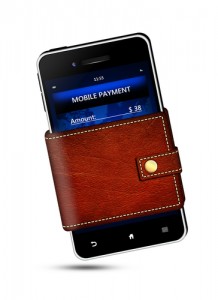The rise of the mobile-wallet
 PayPal recently revealed the findings of a study that paints a dim future for the traditional, man-made wallet due to the rise of the mobile wallet.
PayPal recently revealed the findings of a study that paints a dim future for the traditional, man-made wallet due to the rise of the mobile wallet.
83% of respondents across five countries preferred the option of not carrying a wallet, according to the study conducted by Wakefield Research among 1,000 credit and debit card holders, ages 18 and older.
Uses of a mobile wallet include financial transactions that can be made both faster by cutting down queue time and easier by not burdening customers with small change. Additionally a mobile wallet can also authenticate the holder’s credentials to the point that it can store details of their driver’s license, health card, loyalty card(s) and other ID documents stored on the phone.
“It’s not about replacing cash or your credit card with a new payment method, it’s about using technology to solve real shopping pain points,” said David Marcus, PayPal President. “PayPal is at the forefront of developing products that make life easier, help shoppers be more efficient, and untether consumers from their wallets forever.”
Through features like Check In and Order Ahead, PayPal already provides its 128 million customers with simpler payment experiences that rival the need for a wallet. With the PayPal app, users can use the Check-In feature to pay with just a few clicks and a picture of their face. Consumers can also “order ahead” in select locations with the PayPal app, allowing them to pre-order and have their item waiting for them and already paid for.
JD Sports is yet another retailer to follow in the footsteps of the mobile payment trend. The sports company has rolled out mobile payment across its six brands and 630 UK stores in a partnership with PayPal. The service allows shoppers to pay using their mobiles in-store, via their PayPal account and smartphone app and is available in all of JD Sports’ brands, including Size, Blacks, Millets, Scotts and Bank. As with a regular purchase customers take their goods to the till point for a staff member to scan and record in the EPoS system. But, rather then paying by cash or card the customer can request payment via PayPal. In this case the customer uses the dedicated app to close the payment with a PayPal generated barcode and transaction number that the cashier scans instead.
Rivalling PayPal’s mobile application method for payments, near-field communication (NFC) is also driving the mobile wallet. However according Sandy Shen, research director for consumer services at analyst firm Gartner, NFC payments won’t really hit the mainstream market until 2016. The delay is due to the initial investment post that requires smartphones to have an NFC chip and retailers to have contactless readers. However, David Hodgkinson, KPMG’s customer and channel management practice, argues apps are much cheaper: “Cloud-based branded apps can be a lot less expensive because they are not hardware based.”
Retailers are also taking the initiative to develop their own mobile wallet apps that generally work by allowing customers to load money onto a prepaid account.


No comments yet.